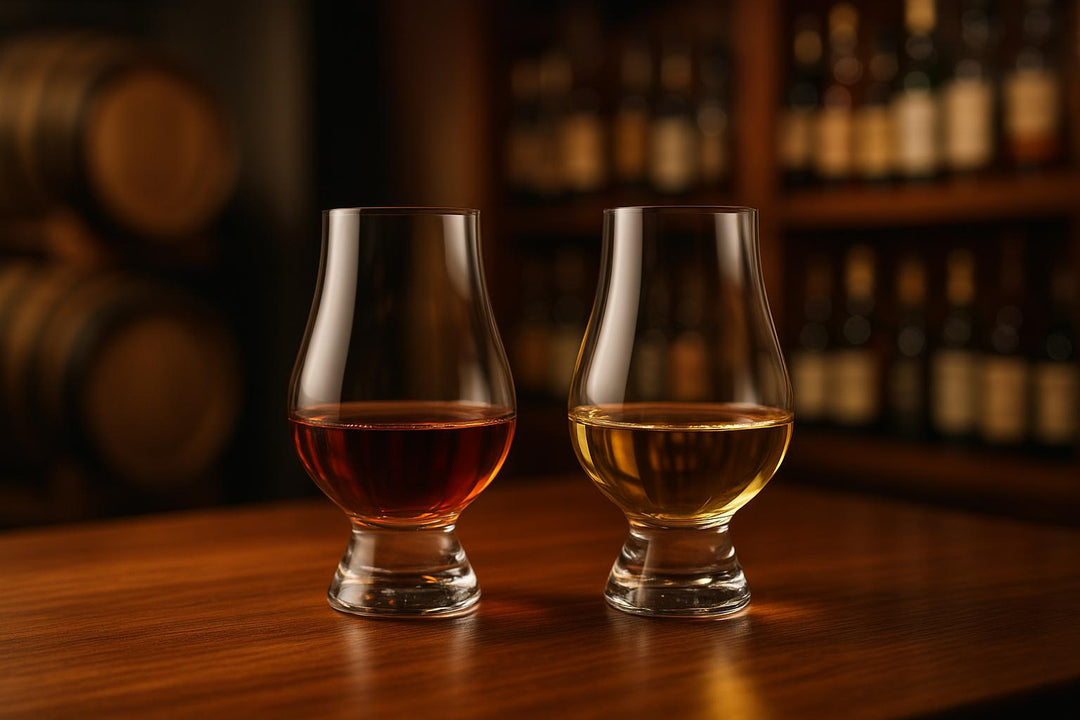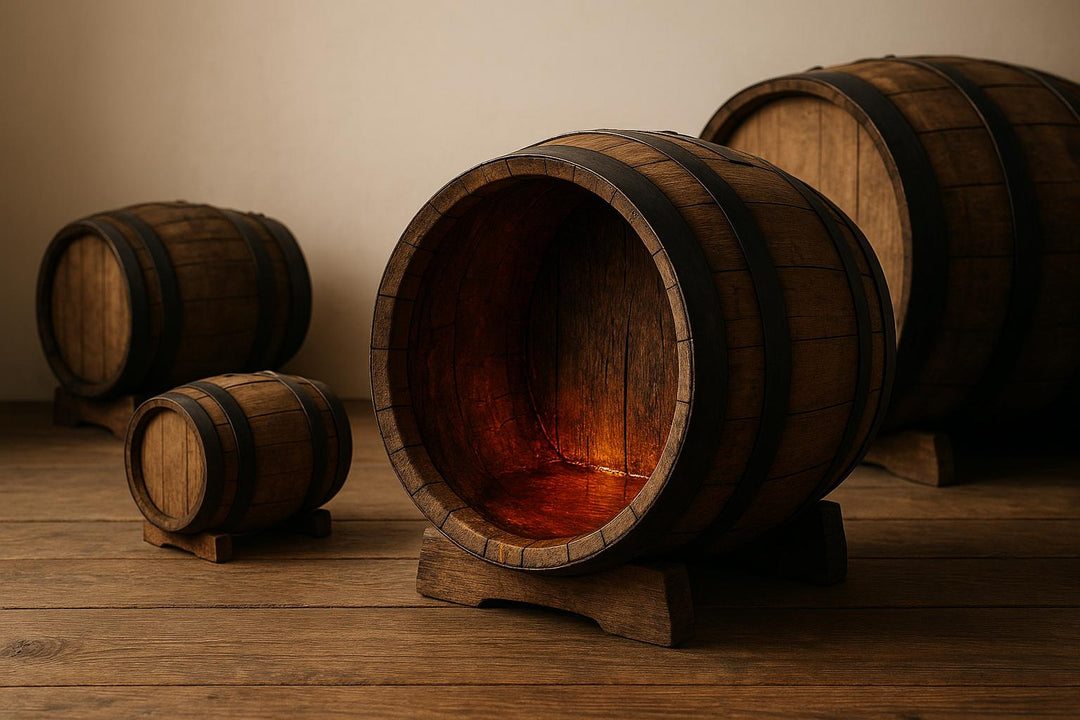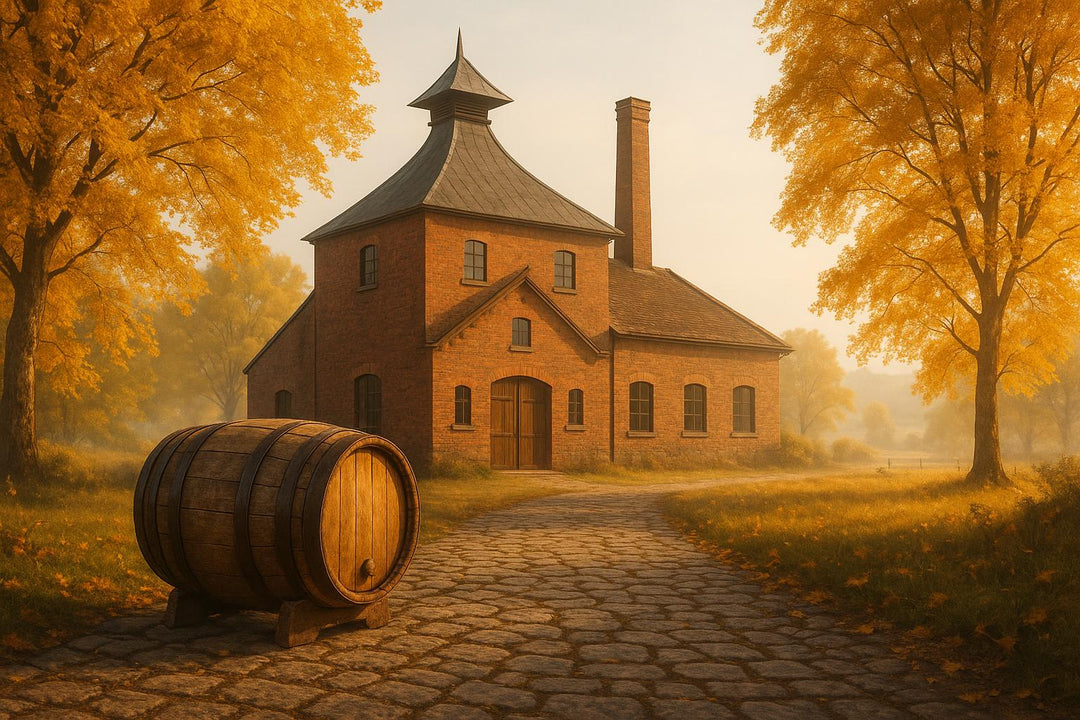Want to keep your rare whisky collection in perfect condition? Here’s how:
- Temperature Matters: Store whisky at a stable 59–68°F (15–20°C). Avoid temperature swings to prevent flavor changes and damage to seals.
- Control Humidity: Maintain 50–70% humidity to protect corks and labels. Too much can cause mold; too little dries corks.
- Keep It Dark: Light, especially UV rays, can ruin whisky’s flavor and color. Store bottles in a dark space or UV-protected cases.
- Store Upright: Always keep bottles upright to avoid cork degradation and leaks. Occasionally tilt sealed bottles to keep corks moist.
- Protect Open Bottles: For opened bottles, reduce air exposure by using inert gas sprays or transferring whisky to smaller containers.
Key Tools: Use whisky cabinets with UV-resistant glass, humidity monitors, and tight bottle seals to safeguard your collection.
Pro Tip: For high-value collections, consider professional storage services with climate control and enhanced security.
Proper storage ensures your whisky retains its quality and value for years to come. Ready to dive deeper? Read on for expert advice!
How To Store Whisky: The Ultimate Guide To Storing Your Whisky Collection
Optimal Storage Conditions for Rare Whisky
Preserving the quality and value of rare whisky requires careful control of temperature, humidity, and light. Here's a closer look at how to manage each factor effectively.
Temperature: Keep It Stable
The sweet spot for whisky storage is between 59–68°F (15–20°C). This range ensures the liquid remains stable, preventing unnecessary stress on the bottle and its contents. Temperature consistency is crucial - fluctuations can cause the whisky to expand and contract, which not only alters its flavor but can also accelerate aging and compromise the bottle's seal. Ideally, temperature changes should stay within 7°F (4°C) to avoid these issues. Additionally, very cold conditions can cause the whisky to appear cloudy.
Tips for maintaining a stable temperature:
- Use a reliable thermometer to keep an eye on storage conditions.
- Set up climate alerts with your home alarm system for immediate notifications of temperature shifts.
- Avoid placing bottles near heat sources like radiators or vents, or near exterior walls prone to temperature changes.
Humidity: Protect Corks and Labels
A relative humidity level of 50–70% is ideal for whisky storage. This range helps preserve corks and labels, both of which are important for maintaining the bottle's condition and resale value. High humidity can lead to mold growth, damaged labels, and degraded corks, while low humidity risks drying out the corks, allowing air to seep in and oxidize the whisky.
"Excess humidity can cause damage to the labels and degrade the cork." - Stephanie McNeil and Maggie Reynolds, Senior Fine Art and Collections Specialists at Chubb
How to manage humidity levels:
- Use tools like humidifiers or desiccants to adjust moisture levels as needed.
- Pair humidity monitoring with your temperature alerts for comprehensive control.
- If precise humidity control isn’t possible, consider removing bottles from cardboard packaging and wrapping them in cling film to protect the labels.
Light: Avoid UV Damage
Exposure to light, especially UV rays, can wreak havoc on whisky. UV rays break down tannins, while visible light can fade the whisky's color and diminish its flavor. Over time, this damage becomes irreversible, leading to evaporation and a loss of potency.
Ways to shield your collection from light:
- Keep bottles in dark storage areas like cabinets or closets, away from sunlight.
- Use motion-activated lighting to reduce exposure when accessing your collection.
- Apply UV-blocking film or install shades on windows in your storage space.
Storage Tools and Equipment for Collectors
Preserving a rare whisky collection requires more than just a cool, dark room. The right tools and equipment can help maintain ideal storage conditions, ensuring your collection stays in top-notch shape for years to come. These tools work hand in hand with proper storage environments to protect your investment.
Whisky Cabinets and Display Cases
A well-made whisky cabinet is a must-have for secure storage and attractive presentation. Look for cabinets with lockable doors, UV-resistant glass, and adjustable shelves to accommodate various bottle sizes. Materials matter too - hardwoods or treated metals are ideal, as they won’t interact with your bottles or introduce unwanted odors. For serious collectors, climate-controlled rooms offer the best protection for high-value collections.
Here’s a quick look at some cabinet options and their features:
| Cabinet Model | Price | Key Features |
|---|---|---|
| Kare Design handcrafted cabinet | $2,670 | Stylish, simple storage |
| Riviera Maison Cape House | $2,020 | Mid-range with display functionality |
| Tamara handmade whisky cabinet | $11,450 | Premium craftsmanship and materials |
| Bulletproof Whisky Vault | $6,000 | High-security storage |
Humidity Monitors and Bottle Seals
Keeping an eye on humidity is crucial for preserving your collection. Digital hygrometers make it easy to monitor humidity levels, ensuring the space stays within the ideal 50–70% range. This protects corks from drying out and labels from damage.
For opened bottles, proper sealing is key to minimizing evaporation and oxidation. Tools like parafilm wraps or inert gas sprays (argon or nitrogen) help maintain the whisky’s quality. If a bottle has a lot of empty space, transferring the whisky to a smaller bottle can reduce the air-to-liquid ratio, slowing oxidation. These small steps can significantly extend the life of your collection.
Cork Care and Maintenance
Caring for corks is just as important as maintaining the whisky itself. Always store bottles upright to prevent the high alcohol content from degrading the cork. However, corks shouldn’t dry out completely - flipping bottles a couple of times a year helps keep them supple and reduces oxidation risks. For bottles you plan to open soon, briefly turning them on their side every few days can keep the cork moist and ready for use. Regularly inspect corks for signs of wear, such as cracking or discoloration, to catch potential issues early.
Proper storage tools and consistent maintenance practices ensure your collection remains pristine, protecting both its quality and value.
sbb-itb-128d6c1
Storage Mistakes That Damage Rare Whisky
Even seasoned collectors can sometimes mishandle their whisky collections, unknowingly affecting both quality and value. Understanding and avoiding these common pitfalls is key to preserving your investment and ensuring your rare bottles remain in excellent condition.
Wrong Bottle Position
Storing whisky bottles on their side might seem harmless, but it can actually damage the cork. Prolonged contact with alcohol can degrade the cork, leading to potential leaks and oxidation. To avoid this, always store your bottles upright. For added care, occasionally tilt the bottle to keep the cork moist, which helps maintain its seal. For rare or high-value bottles, consider using synthetic stoppers for extra protection. Additionally, keep your storage environment consistent to minimize stress on your collection.
Temperature and Humidity Changes
Temperature and humidity play a crucial role in whisky storage. Sudden changes in temperature can cause the liquid to expand and contract, loosening the cork and accelerating oxidation. For instance, bottles exposed to freezing and then thawing may experience noticeable changes in aroma and flavor - up to 10–20% by some estimates.
"Proper temperature and humidity are critical to whiskey storage to preserve its quality and integrity." - Delia Goetzke
High temperatures can speed up aging and introduce unwanted aromas, while excessive humidity risks mold growth. On the flip side, low humidity can dry out the cork, allowing air to seep in and compromise the whisky. Aim for stable conditions to prevent these issues, and steer clear of areas prone to temperature or humidity fluctuations.
Poor Care of Open Bottles
Even with ideal storage for sealed bottles, opened whisky requires a different level of attention. Once a bottle is opened, oxygen exposure starts to degrade the liquid. To slow this process, transfer whisky from half-empty bottles into smaller containers or use inert gas sprays to limit oxidation. Always store open bottles upright, tightly sealed, and aim to finish them within six months.
Inert gas sprays are particularly effective, as they preserve flavor compounds better than vacuum systems. For open bottles, periodically tilting them can keep the cork from drying out, though it’s best to enjoy the whisky sooner rather than later to maintain its quality.
Long-Term Storage Methods for Collectors
For serious whisky collectors, preserving both the quality and the investment value of their bottles over decades requires more than just basic storage know-how. It calls for meticulous attention to storage techniques, comprehensive documentation, and, in some cases, professional assistance.
How to Store Open Bottles
Once a bottle of whisky is opened, oxidation begins, which can alter its flavor over time. To slow this process, it’s important to minimize the amount of air inside the bottle. A simple solution is to transfer whisky from half-empty bottles into smaller containers to reduce headspace.
Always store open bottles upright with a tight seal and keep them in a stable environment between 59°F and 64°F (15–18°C). Avoid direct sunlight and temperature swings, as these can speed up deterioration.
"Once opened, whiskey in the bottle will oxidize faster, and flavor compounds will slowly change and grow dull. Finishing off a bottle of whiskey within two months is best, so bare that in mind when opening sealed bottles." - George Koutsakis, Writer specializing in Japanese whisky and other spirits
While decorative decanters might look appealing, they often don’t provide an airtight seal and should be avoided for long-term storage. Alongside proper storage, maintaining detailed records of your collection is essential for preserving its value and integrity.
Record Keeping and Documentation
Keeping thorough records isn’t just about organization - it’s a key part of turning a whisky collection into a serious investment. Proper documentation can simplify insurance claims, ensure authenticity, and help track market value over time.
At a minimum, collectors should keep purchase receipts, high-quality photos of each bottle (including labels and packaging), and detailed notes on storage conditions. Tracking updated market valuations is also crucial, especially for limited-edition or discontinued bottles that often see significant appreciation.
Digital tools like spreadsheets or specialized whisky inventory software are far more effective than handwritten logs for managing growing collections. Key details to track include:
- Country of origin, distillery, and product name
- Age or vintage, ABV (alcohol by volume), and bottle volume
- Purchase price, vendor, and purchase date
- Current location and whether the bottle is open or sealed
Advanced collectors often go a step further, documenting distillation and bottling dates, cask types, professional ratings, auction values, and even personal tasting notes. Notes on the condition of closures, labels, packaging, and ullage levels (the air gap in the bottle) can also add significant value to the collection.
For bottles intended for resale, detailed records of storage conditions are especially important. Knowing exactly where each bottle is stored - especially if your collection spans multiple locations - can also save time and prevent headaches. For collections of high value, professional storage services offer unmatched climate control and security.
Professional Collection Services
When it comes to high-value collections, professional storage services provide advantages that go far beyond what most home setups can offer. These facilities are designed to maintain ideal conditions while offering enhanced security and documentation, which can protect and even increase the value of a collection over time.
Professional storage facilities ensure precise temperature and humidity control, eliminating the fluctuations that are common in home environments. This consistency is critical, especially considering that rare whisky values rose by 564% over the ten years leading up to 2019.
Security is another major benefit. These facilities typically feature 24/7 monitoring, restricted access, and fire suppression systems tailored for alcohol storage. Such measures protect against theft, damage, and environmental risks that could harm a valuable collection.
Additionally, professional facilities often provide better insurance options than standard homeowner’s policies, which may not fully cover rare whisky collections. These specialized policies are designed to address the unique risks associated with storing valuable spirits.
For collectors with limited space, inadequate climate control, or a collection that has grown too valuable to comfortably store at home, professional storage is a smart choice. This option is particularly appealing for those treating whisky as a serious investment rather than a hobby. The detailed documentation and provenance offered by professional facilities can significantly boost the resale value of rare bottles.
Partnering with experts like The Really Good Whisky Company can provide tailored advice on managing high-value collections, ensuring that your storage solutions align with your specific needs and investment goals.
Key Points for Storing Rare Whisky
Storing rare whisky correctly comes down to managing four key factors: maintaining a stable temperature (59–68°F), controlling humidity (50–70%), keeping bottles away from direct sunlight, and always storing them upright. These steps are crucial, not just for preserving the whisky's quality but also for protecting your investment - especially when you consider that a bottle of Macallan Fine and Rare 60-Year-Old 1926 fetched $1.9 million in October 2019.
Here’s a closer look at these storage essentials:
- Temperature Stability: Fluctuating temperatures can weaken seals and speed up oxidation, which harms the whisky. Store bottles in a cool, dark space, far from vents or windows, to ensure consistent conditions.
- Humidity Control: Use a hygrometer to monitor humidity levels, aiming for the ideal range of 50–70%. Too much humidity can damage labels and encourage mold, while too little can dry out corks, allowing air to seep in. Adjust with a humidifier or dehumidifier as needed.
- Shield from Light: Ultraviolet rays can alter the whisky’s flavor and color through chemical reactions. To prevent this, keep bottles in their original packaging or consider UV-protected display cases for collections on show.
- Bottle Positioning: Always store whisky upright. Lying bottles on their sides can cause corks to degrade, leading to contamination or oxidation. Occasionally tilting sealed bottles helps keep corks moist, but avoid prolonged horizontal storage.
For opened bottles, the risk of oxidation increases as the liquid level drops. To minimize this, transfer the remaining whisky into a smaller container once the bottle is half-empty. Avoid storing whisky in refrigerators or freezers, as excessively cold temperatures can dull its flavors and aromas.
Invest in whisky cabinets, humidity monitors, and quality bottle seals to safeguard your collection. For opened bottles, inert gas sprays like argon or nitrogen can create a protective barrier, slowing oxidation.
Remember, whisky doesn’t age in the bottle; proper storage ensures it retains its original quality. Pay attention to temperature, light, humidity, and cork care to keep your collection in pristine condition.
For personalized advice and storage solutions, reach out to The Really Good Whisky Company.
FAQs
What are the risks of storing rare whisky in an uncontrolled environment?
Storing rare whisky without proper climate control can jeopardize both its quality and value. For starters, temperature and humidity fluctuations can dry out the cork, which might result in evaporation or spoilage. On the flip side, excessive humidity can lead to mold or mildew, while overly dry conditions risk damaging the labels and packaging.
Temperature swings are another concern - they can speed up the aging process and potentially alter the whisky's flavor. To keep your collection in top condition, aim for a stable environment with moderate temperatures (around 59°F to 68°F) and consistent humidity levels between 40% and 60%.
What’s the best way to store an open bottle of rare whisky to preserve its quality?
To keep an open bottle of rare whisky in great condition, store it upright in a cool, dark, and dry spot, away from sunlight and temperature swings. Ensure the bottle is tightly sealed to reduce air exposure, as oxygen can lead to oxidation and negatively affect the flavor over time.
Steer clear of placing the bottle near heat sources like radiators or ovens, and avoid areas with high humidity. If you want extra protection, consider using specialized bottle caps or seals that limit air contact. Taking these steps will help preserve the whisky’s flavor and maintain its value for years.
What should I look for in a whisky cabinet to protect and showcase my collection?
When picking out a whisky cabinet, it's important to focus on security and preservation. Choose one with lockable doors to keep your collection safe and UV-protected glass panels to prevent light from damaging your bottles. The cabinet should also maintain a consistent temperature and humidity level, as fluctuations can harm the whisky over time.
Look for cabinets made from sturdy materials like quality wood or steel, and ensure they have adjustable shelves to fit bottles of different shapes and sizes. Proper shelving helps keep bottles steady and avoids accidental spills. Beyond protection, a thoughtfully designed whisky cabinet adds a touch of elegance, letting you showcase your collection in style.







Leave a comment